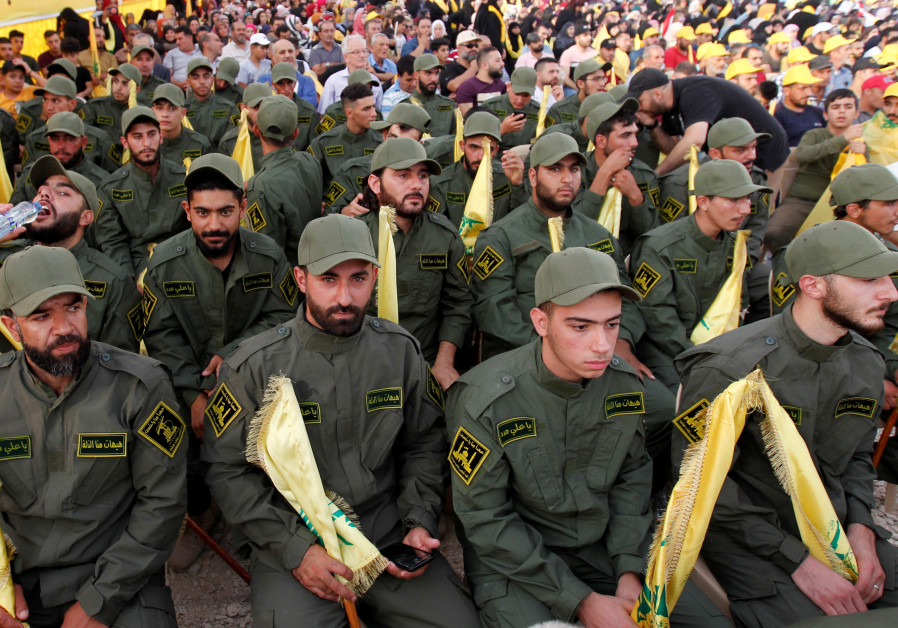The Shi’ite shrine in Damascus spotlighted after recent airstrikes

Lebanon’s Hezbollah members hold party flags as they listen to their leader Sayyed Hassan Nasrallah addressing his supporters via a screen during a rally marking the anniversary of the defeat of militants near the Lebanese-Syrian border, in al-Ain village, Lebanon August 25, 2019. . (photo credit: REUTERS)
On Monday crowds gathered to pay their respects to two fallen Lebanese Shi’ites who were killed in an Israeli airstrike south of Damascus. The IDF said they were members of a militia linked to the Islamic Revolutionary Guard Corps Quds Force and involved in attempts to attack Israel. For the crowds the men were the latest martyrs in the long war that has raged in Syria since 2011. For the faithful gathered, they were members of the “resistance” and their coffins were wrapped in red banners memorializing Sayyida Zeinab, a granddaughter of the prophet Mohammad.
Zeinab and her tomb has been a gathering place for fighters who came to aid the Syrian regime during the civil war in Syria. Sometimes called Set Zaynabi, the area is home to Shi’ites and a large mosque and complex that contains the holy shrine. In 2012 members of Hezbollah and other Shi’ites came to the mosque to defend it. More than 45 members of Hezbollah died fighting near there, according to the Meir Amit intelligence and information center, constituting around four percent of Hezbollah’s loses in Syria. But many of the others who died fighting in Syria were called “Zaynabi martyrs,” as if they had died fighting for the shrine.
The two men killed in the airstrike, Hasan Yousib Zbib and Yasir Ahmad Dahir now join the list. These men were born in 1996 and 1997. The importance of the shrine is like other Shi’ite sites that have been defended or rebuilt in the context of the recent war. Another shrine to Zeinab exists in Sinjar in Iraq and has been rebuilt by Shi’ite fighters. These Shi’ite sites have also been targeted by ISIS and other jihadists in recent years. More than 70 were murdered in a bombing near the Zeinab shrine in 2016.
تفاصيل مقتل عنصر من ميليشيا “حزب الله” ذبحاً في السيدة زينب بدمشق#أورينت
لقراءة الخبر كاملاً اضغط على الرابط https://t.co/pTTZ6N32bs pic.twitter.com/KDjrn2FZnW— Orient أورينت (@OrientNews) August 27, 2019
The shrine represents more than just a religious site or a gathering place for militia members, it is part of an ecosystem that unites those across the region who see the cause in Syria as more than just fighting to preserve the regime, and see being members of Hezbollah or the IRGC or Shi’ite militias as more than just being members of an armed group. Lost in some of the discussion about Israel-Iran tensions or US Iran tensions or stories of “killer drones” is this more human devotional element. Some of those who travelled from as far away as Afghanistan to fight in Syria wanted to defend the shrine and defend Shi’ites and others.
The shrine has also been in the spotlight over the last day due a personal feud that apparently resulted in the death of a Hezbollah member who was killed in an act of personal revenge. The full story is not yet clear. “A terrible crime, a young man slaughtered in cold blood in the shrine,” says the website El-Bayan. Other reports called the crime “horrific.”
The shrine will continue to play an important role as a place of gathering for devotees across the region. It played a key role in the Syrian war. It was a unifying force and was once also the headquarters of a regiment called the Rapid Intervention Regiment. A member of the unit told researcher Aymenn Jawad al-Tamimi in 2017 that he was an Iraqi born in Syria and that “as soon as the crisis began and the danger arose to Sayyida Zainab, we put our trust in God and became soldiers of the Imam.” Later he became affiliated with Lebanese Hezbollah.
This shows the network of Syrian, Iraqi and Lebanese Shi’ites who, under the banner of defending the shrine, joined together in 2012 and 2013 and have continued on from there with different armed groups. While Iran’s role in Iraq and Syria is sometimes seen as a “land bridge” to Hezbollah, it is also very much a land bridge built on personal and religious connections on the ground between groups who have fought together for years for a common cause. It is more complex for them than just seeing their role as one related to the US or Israel, when many originally joined out of a belief, in part, that they were serving a cause to defend their coreligionists and a shrine.
For the two men killed by Israel in the airstrike on August 24 and who were buried near the shrine, the war is now over. The IDF statement says that they stayed in Iran many times over the past year and underwent training with the Quds Force. Photos show them on Mahan Air. “The two operated during the last few weeks as part of the Shi’ite militias, under the command of the Quds Force, in order to carry out the drone attack against Israeli targets.”
`; document.getElementById(“linkPremium”).innerHTML = cont; (function (v, i){ });





Comments are closed.